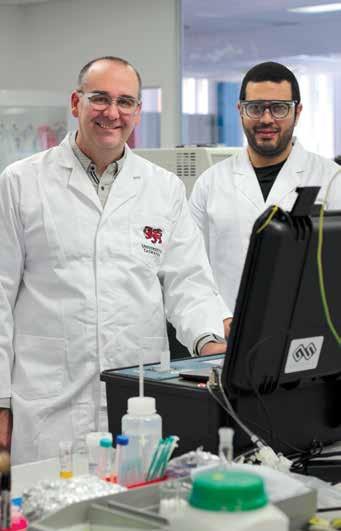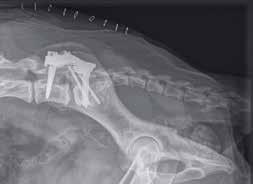
6 minute read
From bomb-detection to virus-detection – World-first
from AMT AUG/SEPT 2020
by AMTIL
From bomb-detection to virus-detection In a fascinating tale of transformation and ingenuity, Melbourne-based GreyScan worked with the University of Tasmania in a race to develop the world’s first mobile virus detection device, re-engingeered from a device that was originally an explosives-detector.
The SARS-CoV-2 coronavirus strain at the heart of the the COVID-19 pandemic cannot be seen, is difficult to detect, and is continuing to mutate as scientists race to find a vaccine. According to recent studies, the virus is detectable in aerosols for up to three hours, up to four hours on copper, up to 24 hours on cardboard, and two-three days on plastic and stainless steel. Currently there are no means to check how effective cleaning protocols are, or to determine the virus’s presence in public places. There is therefore a significant need for environmental testing for COVID-19 to determine whether hospitals, schools, surfaces and personal protective equipment are clear of the virus. In order to jumpstart the economy, proactive – rather than reactive – methods to quickly identify the virus must be developed. A company developing such a proactive tool is Port-Melbourne-based GreyScan, in collaboration with the University of Tasmania. This exciting research project could pave the way for the development of a world-first: a mobile virus detection device that will be able to detect the coronavirus on surfaces. The science of “trace detection” expands on the trace explosives detection technology invented 15 years ago by Professor Michael Breadmore’s team at the University of Tasmania, and commercialised, manufactured and deployed by GreyScan. Breadmore recalls the challenge: “We were asked to rapidly detect explosives and reduce a 30-minute process to 30 seconds.” The resultant device, the GreyScan ETD-100, was the world’s first compact, inorganic explosives trace detector, which is capable of detecting trace levels of explosives in a few minutes. The technology is the first in the world to detect homemade inorganic explosives, overcoming the limitation of existing screening techniques that struggle to detect modern explosives. Employed globally, it outperforms by up to ten times the current standards sought by the US Government. The modular nature of the explosives-detector allows it to be reengineered to detect a wide variety of substances, including viruses. “It is not possible to implement existing diagnostic approaches in a time that is suitable for rapid screening,” says Breadmore. “Our approach is truly unique in the world and in the diagnostic space.” GreyScan CEO Samantha Ollerton says the research represented the first step towards developing the GreyScan TVD-1 (Trace Virus Detector), which could be used to detect the virus in airports, public transportation systems and places of mass gatherings, as well as being deployed in the testing of people. The device would help the public to feel safe again and enable people to return to their normal routines by demonstrating that cleaning or decontamination protocols have been followed. “The use of contact tracing and people testing will be augmented by the capability of the TVD-1, providing fast, accurate detection that can be used by anyone anywhere” adds Ollerton. The technology is based on capillary zone electrophoresis (CZE) – a technique previously used for the analysis and characterisation of human viruses such as common cold virus and adenovirus. The initial research is supported by $260,000 in co-funding from the CSIRO Innovation Connections Grant scheme and industry partner GreyScan. “This is a product for the future fight against this and any other viruses that we encounter in our lifetimes.” Adds Ollerton. The research is taking place in the University of Tasmania’s lab facilities, where Breadmore will be joined by a team of researchers
Professor Michael Breadmore and Mostafa Adel Atia Abuzeid with the GreyScan unit at the University of Tasmania.
"Our research will develop a way to collect, analyse and detect viruses from surfaces within a few minutes." Professor Michael Breadmore
who will develop biosensors to help detect the virus. Professor Anna King explains that biosensors played an important role by binding to and detecting viruses such as SARS-CoV-2. “We will be developing multiple types of biosensors that can bind to the virus in different ways, as well as the systems that best allow us to detect even the smallest amounts of the virus,” she adds. GreyScan believes this device will be the first in a line of products that will be able to detect surface viruses as they evolve and spread throughout the globe. It is suggested that an engineering prototype will be ready within six months, then a more advanced prototype for testing in the field is expected to be ready in 12 months. The GreyScan ETD-100TM explosives-detection device was a world-first then, and its transformation to virus-detection is a worldfirst now, as it tackles one of the world’s biggest health challenges.
www.greyscandetection.com www.utas.edu.au
Personalised nutrition smart patch to be developed in Australia A wearable smart patch designed and manufactured in Australia will deliver precision data to help people personalise their diets and reduce their risk of lifestyle-related chronic diseases like Type 2 diabetes.
The world-first personalised nutrition wearable patch being developed by Melbourne-based start-up Nutromics painlessly measures key dietary biomarkers and sends the information to an app, enabling users to precisely track their bodies’ response to different foods. A collaborative team led by Nutromics, RMIT University, Griffith University, and established medical device manufacturer Romar Engineering, with support from the Innovative Manufacturing Cooperative Research Centre (IMCRC), is now developing the capabilities required to pilot manufacture the device. Diabetes is one of the largest chronic health challenges globally, but with early interventions and lifestyle changes, the condition is often preventable. Nutromics co-CEO Peter Vranes said the smart patch leverages emerging technologies to empower people to take greater control of their health: “Research has shown that what we eat affects us all differently; two people might have the same meal but their post-meal response can vary wildly. People want to make healthy food choices but with so much conflicting nutrition advice, many of us are confused. Being able to easily monitor key dietary biomarkers will give you the knowledge to personalise your diet to suit your own body, get healthy and stay healthy.” The smart patch combines a complex sensing platform and stretchable electronics for improved conformity to skin. The fabrication of sample collection will be led by Griffith University and Romar Engineering, with sensor integration and stretchable electronics fabrication undertaken at RMIT’s cutting-edge Micro Nano Research Facility. Professor Sharath Sriram, Research CoDirector of RMIT’s Functional Materials & Microsystems Research Group, said RMIT researchers would integrate the technologies in a prototype smart patch manufactured via roll-to-roll (R2R) printing. “This smart patch is a significant evolution in wearable health monitoring technology,” he said. “Current wearable technologies can track your heart rate and steps, but they can’t monitor your health at a molecular level. This technology goes deeper, targeting the precise biomarkers that drive lifestyle-related diseases like Type 2 diabetes.” Alan Lipman, CEO of Romar, said collaboration was the way forward for Australian manufacturing: “Working with entrepreneurs, academics and researchers to develop new medical technologies is essential to maintain Australia’s international competitiveness and to build a strong domestic manufacturing skills base.”
www.nutromics.com.au www.rmit.edu.au www.griffith.edu.au www.imcrc.org www.romareng.com.au
REAL-WORLD PARTS FOR PRODUCTION & PROTOTYPING
RAM3D is a market leader in additive manufacturing focusing on selective laser melting (SLM).

With over 10 years’ experience in the additive manufacturing industry, their services Include:
• Metal 3D printing, consultation on design for additive manufacturing and polishing options. • They print in Stainless Steel 15-5ph and 316L, Titanium 64,
Inconel 718 (high temp alloy) and Aluminium (AlSi10Mg).
They will be introducing maraging steel, a tool steel, in 2020.

GET INTOUCH
P +64 7 557 0344 ram3dprinting www.ram3D.co.nz E info@ram3d.co.nz ram3dprinting










